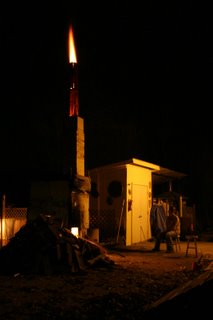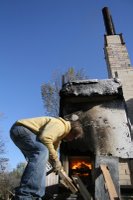
The kiln has now been fired fifteen times. Her name is Patricia, because she is level-ish and the bricks were stacked straight-ish. We fired her for possibly the last time yesterday, Saturday, October 14th. It was fired by Tony (who has fired the kiln with me many times), Brandon (who signed up for the firing as a class through the Edina Art Center), my wife Rachael, and myself.
Fifteen firings is a pretty short life span. A kiln of that size and design would typically be expected to last at least 100 firings. It is designed to fire glazed pots rapidly. Unlike many contemporary wood kilns, it is not meant to deposit a lot of ash on the pots. It is, rather, a design an individual potter might use to fire glaze-ware when they would prefer to use wood as fuel instead of oil, gas, or electricity. The kiln is relatively small, and a potter using it as their primary kiln would likely fire it once a month or so.

If this really proves to be the final firing, why the early retirement? Simply put, it was the first kiln built by everyone involved in its construction and we didn't know what we were doing. It was built by my high school students, and as we have fired it we have learned many things we should have done differently. It is an Olson fast fire design. In theory it should be able to fire in six hours. Our average firing time has been about 18 hours and is getting longer. Why it is getting longer of late I really don't know, but my guess is that the gaps in the bricks are getting wider as the metal frame around it continues to expand and the arch continues to droop. But as for the extremely long firing times, the primary problem is that the kiln was built with hard brick instead of soft brick. Soft brick is an excellent insulator. Firing a kiln built of soft brick involves heating the pots in the kiln, the shelves, the air around them, but not the kiln itself. Hard brick is not an insulator. It absorbs heat and gives it off. When firing a hard brick kiln, you need to heat the kiln itself to temperature and that takes a lot of caloric energy.

Brandon started this last firing at 5:00 am. Tony came in at 10:00 am and worked with Brandon until 11:00. At that point Brandon went home and Tony worked alone until I arrived at 2:30. I made several runs for pallets during the day, and then we worked steadily for several hours to cut them all up before we ran out of daylight. It has typically been taking us fifty pallets to reach temperature. Rachael came to help at about 7:30 and Tony went home to prepare for a raku firing he was doing the next day at the Eagan Art Center. Rachael and I finished busting up the wood and then settled in for our work. I was expecting we would reach temp by 1:00 am. We called it a night at 3:00 am, and cone 8 was only halfway down on the bottom. That was 20 hours, and in my book it just isn't worth it for the number of pots that fit in it. I think we could easily build a kiln that can hold four or five times the number of pots and fires in 30 hours.

So If any of the students who built that kiln ever read this, I thank you for your work. I have to laugh at how many nights we struggled into the wee hours of the morning trying to get that thing up to temp. Your parents must have thought your ceramics teacher was some sort of cruel and insane pyromaniac. I am amazed that none of them ever protested, or called me with concerned questions about what I was doing with their children until three in the morning. In the end I have learned a great deal from this experience. I hope to build more kilns in the future and maybe we will get a chance to fire together again.
1 comment:
Post a Comment